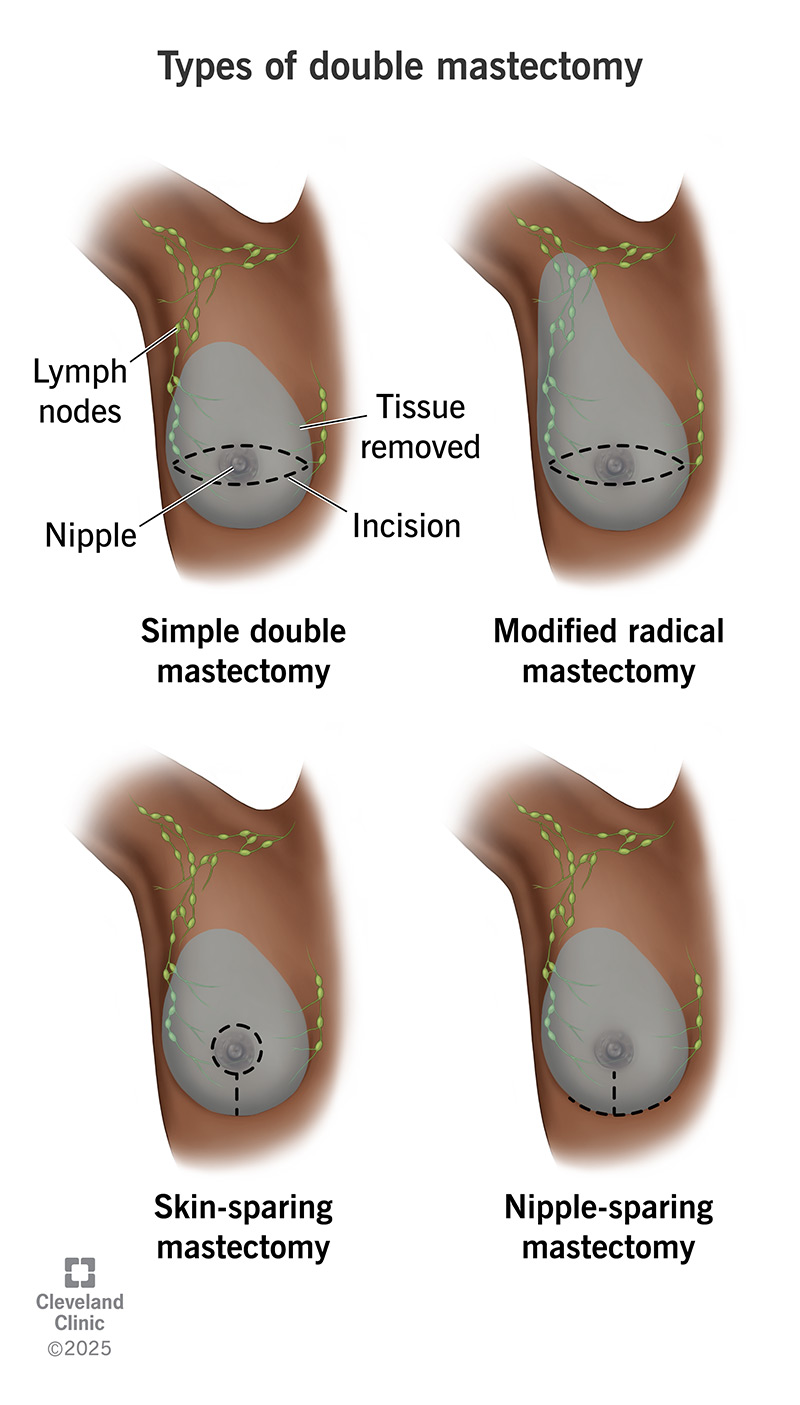A double mastectomy is a surgery to remove both of your breasts. It’s a treatment for breast cancer. If you have a very high risk of developing cancer in both breasts, you might choose a double mastectomy to prevent it. After removing your breasts, your surgeon can reconstruct them if you choose. This makes the surgery and recovery a little longer.
Advertisement
Cleveland Clinic is a non-profit academic medical center. Advertising on our site helps support our mission. We do not endorse non-Cleveland Clinic products or services. Policy

A double mastectomy (bilateral mastectomy) is a surgery to remove both of your breasts. Mastectomy means removing breast tissue. A double mastectomy removes all of your breast tissue on both sides.
Advertisement
Cleveland Clinic is a non-profit academic medical center. Advertising on our site helps support our mission. We do not endorse non-Cleveland Clinic products or services. Policy
You might need this surgery if you develop breast cancer in both breasts, or if you’re very likely to. Surgeons remove all the tissue where cancer can grow to stop it from growing and spreading.
Different types of double mastectomy procedures have slightly different steps. Types include:
Advertisement
Your surgeon will explain which versions of the procedure they recommend for you and why.
Before scheduling a double mastectomy, you and your healthcare provider will discuss your condition and make a treatment plan. You’ll decide together if and how a double mastectomy fits into the plan.
Your provider will tell you what parts they need to remove and if they can save your skin or nipples. You’ll decide if you want to have breast reconstruction surgery at the same time or later, or at all.
Your plan may include other cancer treatments, either before or after your surgery. These plans may affect the timing of your breast reconstruction surgery or the methods your surgeon can use.
Your provider will also explain how to prepare for your surgery and your recovery at home. You may want to make some adjustments in your home or arrange for someone to help you with certain tasks.
You’ll have general anesthesia for the procedure, so you’ll sleep through it. Once you’re asleep, your healthcare team will place a breathing tube in your throat to keep your airways open during surgery.
A provider will inject a substance into your breasts to locate your lymph nodes. Sometimes, they use a blue dye. Other times, they use a mild radioactive tracer. And sometimes, they use both.
Your surgeon will:
You can expect to spend at least a few hours in surgery for a double mastectomy. If you have breast reconstruction at the same time, it can be six to 10 hours. Your surgeon will tell you what to expect.
The benefits of a double mastectomy depend on your breast cancer risk or cancer stage. If your healthcare provider has recommended it for you, it’s because they believe it might be lifesaving.
All surgeries carry certain risks, including infection, bleeding and nerve damage. Having surgery on both of your breasts increases your risk of complications. But the risks of cancer are far greater than these.
Advertisement
Surgery isn’t the only way to treat or prevent cancer. Your provider will discuss all of your options with you. It’s not always the best option for everyone. But surgery is one of the most effective tools we have.
If you have cancer and it hasn’t spread yet, surgery is almost always your best bet. If you don’t have cancer, but your breast cancer risk assessment is high, your provider will discuss the pros and cons.
Side effects or delayed complications of the procedure can include:
Most can go home the same day. But in some cases, you may spend a night or a few nights in the hospital after your mastectomy. Your healthcare team will monitor you for complications.
Advertisement
They’ll also explain how to care for yourself at home, including:
You’ll have a follow-up appointment with your provider in a couple of weeks. At this time, you’ll discuss the pathology report from the lab that studied your tissues and what it means for your treatment plan.
Recovery from a double mastectomy takes time, especially for more complex surgeries. It takes at least four weeks for your wounds to heal. It may take up to eight weeks if you had reconstruction at the same time.
During this time, you’ll need to avoid driving, reaching and heavy lifting. Your arms and chest will feel stiff and tight. Practicing your exercises every day will help relieve stiffness and promote healing.
You may have your surgical drains in for all or some of this time. They can be awkward under your clothes and when you’re trying to sleep. You can buy special mastectomy bras that hold them in place.
You may feel tired for weeks or even months afterward. You may also feel various sensations in your chest as your nerves slowly recover. Some people continue to feel numb in their chest for years.
Advertisement
Contact your provider if you have signs or symptoms of complications, like:
Having a double mastectomy is a major decision — even if it feels like it isn’t a choice at all. Your healthcare team understands what this means for you — physically, emotionally and practically.
Your team can offer a lot of advice and resources to help you through this process. They can also connect you with outside support networks. Don’t hesitate to reach out for the help you need.
Having a lumpectomy or mastectomy is the first step toward healing from breast cancer. Cleveland Clinic breast cancer surgeons offer expertise and compassion.

Last reviewed on 06/09/2025.
Learn more about the Health Library and our editorial process.